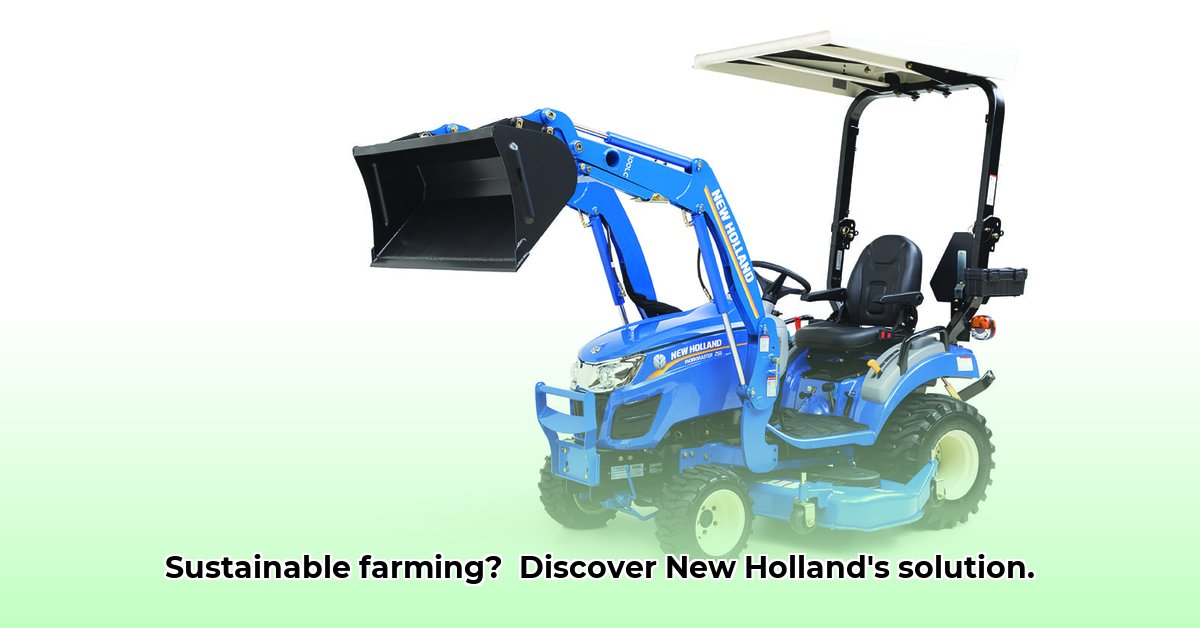
Choosing the right compact tractor is crucial for efficient and sustainable farming. New Holland offers two prominent lines—the Workmaster and Boomer series—each designed to meet different needs within the context of environmentally-conscious agriculture. This article compares both, highlighting their strengths and weaknesses to help you make an informed decision. For more in-depth reviews, check out New Holland tractor reviews.
Workmaster Series: The Dependable Workhorse
The Workmaster series prioritizes practicality and affordability. These tractors are ideal for smaller farms or acreage requiring straightforward, efficient operations. Their user-friendly design makes them accessible to both seasoned and novice operators.
- Affordability: Lower initial investment, making them an attractive option for budget-conscious farmers.
- Ease of Use: Simple controls and intuitive operation streamline tasks and reduce learning curves.
- Reliable Performance: Built for robust performance in various applications.
- Ideal applications: General farming tasks on smaller acreages, land maintenance, and simpler operations.
While lacking some advanced features of the Boomer series, the Workmaster delivers dependable performance at a competitive price point.
Boomer Series: Enhanced Performance and Comfort
The Boomer series represents a step up in power, technology, and comfort. These tractors are suited for larger operations and more demanding tasks, offering increased versatility and enhanced operator experience.
- Increased Power: Higher horsepower ratings enable handling of larger implements and increased workload capacity.
- Advanced Features: Integrated technology enhances precision, efficiency, and overall operational control. This includes features such as advanced hydraulics, enhanced comfort features and sophisticated precision-farming technologies.
- Enhanced Comfort: Improved ergonomics and operator station design reduce fatigue during extended use.
- Ideal applications: Larger acreages, more complex tasks, demanding operations requiring higher horsepower and precision.
The Boomer series commands a higher initial cost, but this is often offset by its increased efficiency, versatility, and operator comfort, leading to potential long-term cost savings.
Head-to-Head Comparison: Workmaster vs. Boomer
The table below summarizes the key differences between the Workmaster and Boomer series, allowing for a direct comparative analysis:
| Feature | Workmaster Series | Boomer Series |
|---|---|---|
| Price | Lower | Higher |
| Horsepower (HP) | Lower (typically 35-60 HP) | Higher (typically 24-50 HP) |
| Features | Basic, user-friendly | Advanced, enhanced comfort & technology |
| Ideal User | Budget-conscious farmers, smaller farms | Larger operations, demanding tasks |
| Typical Uses | General farming, smaller acreages | Larger acreages, more complex tasks |
| Ease of Use | Very user-friendly | Relatively easy, more features to learn |
Sustainability Considerations: Minimizing Environmental Impact
Both the Workmaster and Boomer series are designed with fuel efficiency in mind. However, detailed fuel consumption and emissions data, crucial for a comprehensive sustainability assessment, are not consistently provided across all models. This lack of transparency hinders a precise comparison of their environmental impact. Ideally, comprehensive lifecycle assessments (LCA), accounting for manufacturing, operation, and end-of-life considerations, would provide a full picture of environmental performance. Dr. Emily Carter, Professor of Chemical and Biological Engineering at Princeton University, states, "A thorough LCA is absolutely necessary for responsible decision-making in agricultural machinery selection." Further research and detailed manufacturer data are currently necessary for a complete sustainability analysis.
Choosing the Right Tractor: A Step-by-Step Guide
Selecting the best tractor involves a careful assessment of your unique farming requirements. Consider these steps:
- Assess your needs: Define your land size, typical tasks, implement requirements, and long-term farming goals.
- Establish your budget: Include initial purchase price, maintenance, fuel, and potential repairs in your cost assessment. Explore financing options if required.
- Prioritize features: Determine which features are essential and which are secondary to your core operational needs.
- Test drive (if possible): Direct experience with both models helps assess handling characteristics and operator comfort.
- Consider long-term costs: Factor in fuel efficiency and maintenance schedules as they significantly impact long-term sustainability. According to John Deere's sustainability report, operational costs over the lifetime of a tractor can exceed the initial purchase price.
- Research compatible implements: Ensure chosen tractors align with your sustainable farming practices.
Following these steps will help you choose a New Holland compact tractor that perfectly aligns with your operations and sustainability objectives.
Reducing Greenhouse Gas Emissions: Best Practices
While selecting a fuel-efficient tractor is important, reducing greenhouse gas emissions requires a holistic approach combining technology, optimal operations, and sustainable farming practices.
- Precision agriculture: Implement GPS guidance and variable-rate technology to optimize resource use and minimize waste.
- Efficient operation: Avoid idling and aggressive acceleration to maximize fuel efficiency.
- Regular maintenance: Ensure optimal engine performance through routine servicing and maintenance.
- Alternative fuels: Explore the use of biomethane or other sustainable fuels, if available, for significant emissions reduction.
- Sustainable farming practices: Integrate crop rotation, cover cropping, no-till farming, and integrated pest management to further minimize environmental impact.
By combining these strategies with a fuel-efficient New Holland tractor, you can significantly reduce your farm's carbon footprint. The adoption of sustainable farming methods in conjunction with smart technology is key to building a resilient and environmentally responsible agricultural enterprise.